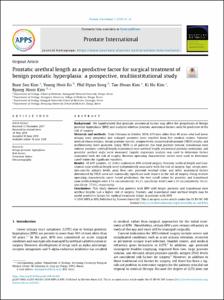Prostatic urethral length as a predictive factor for surgical treatment of benign prostatic hyperplasia: a prospective, multiinstitutional study
- Keimyung Author(s)
- Kim, Byung Hoon
- Department
- Dept. of Urology (비뇨의학)
- Journal Title
- Prostate International
- Issued Date
- 2019
- Volume
- 7
- Issue
- 1
- Abstract
- Background:
We hypothesized that prostatic anatomical factors may affect the progression of benign prostatic hyperplasia (BPH) and analyzed whether prostatic anatomical factors could be predictive of the risk of surgery.
Materials and methods:
From February to October 2014, 679 men older than 40 years who had lower urinary tract symptoms and enlarged prostates were enrolled from five medical centers. Patients' medical characteristics, serum prostate-specific antigen levels, transrectal ultrasound (TRUS) results, and uroflowmetry were analyzed. Using TRUS in all patients, the total prostate volume, transitional zone volume, prostatic urethral length, transitional zone urethral length, intravesical prostatic protrusion, and prostatic urethral angle were measured. Logistic regression analysis was used to determine factors associated with the risk of surgery. Receiver operating characteristic curves were used to determine cutoff values for significant variables.
Results:
Of 679 patients, 37 (5.4%) underwent BPH-related surgery. Prostatic urethral length and transitional zone urethral length were independently associated with the risk of surgery. Age, serum prostate- specific antigen levels, peak flow rate, postvoid residual urine, and other anatomical factors determined by TRUS were not statistically significant with respect to the risk of surgery. Using receiver operating characteristic curveebased predictions, the best cutoff values for prostatic and transitional zone urethral length were 4.53 cm (sensitivity: 83.3%, specificity: 61.6%) and 3.35 cm (sensitivity: 83.3%, specificity: 77.9%), respectively.
Conclusions:
This study showed that patients with BPH with longer prostatic and transitional zone urethral lengths had a higher risk of surgery. Prostatic and transitional zone urethral length may be useful predictive factors for medical treatment failure in patients with BPH.
- Keimyung Author(s)(Kor)
- 김병훈
- Publisher
- School of Medicine (의과대학)
- Citation
- Bum Soo Kim et al. (2019). Prostatic urethral length as a predictive factor for surgical treatment of benign prostatic hyperplasia: a prospective, multiinstitutional study. Prostate International, 7(1), 30–34. doi: 10.1016/j.prnil.2018.06.002
- Type
- Article
- ISSN
- 2287-903X
- Source
- https://www.sciencedirect.com/science/article/pii/S2287888217301605?via%3Dihub
- Appears in Collections:
- 1. School of Medicine (의과대학) > Dept. of Urology (비뇨의학)
- 파일 목록
-
-
Download
 oak-2019-0099.pdf
기타 데이터 / 601.11 kB / Adobe PDF
oak-2019-0099.pdf
기타 데이터 / 601.11 kB / Adobe PDF
-
Items in Repository are protected by copyright, with all rights reserved, unless otherwise indicated.